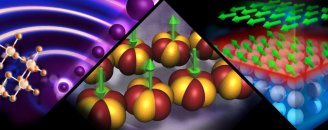Copyright 2012 neutronsources.org | All rights reserved. | Powered by FRM II | Imprint / Privacy Policy
Neutrons before and after the 2016 Nobel Prize in Physics

Date: 09/11/2016
Contributions by (in alphabetical order) Andrea Voit / FRM II, Daniel Banks / CNBC, Jeremy Rumsey and Katie Bethea / ORNL, Laura Hennemann / PSI, Sara Fletcher / ISIS, Sylvain Petit / LLB. Edited by Inês Crespo / FRM II, SINE2020
This article showcases work conducted at neutron sources around the globe that confirmed the predictions of the winners of the 2016 Nobel Prize in Physics or that builds upon their theories. More details will be published next year in the journal Neutron News.
The Nobel Prize in Physics 2016
This year’s Nobel Prize in Physics was awarded to David J. Thouless (University of Washington, USA), F. Duncan M. Haldane (Princeton University, USA), and J. Michael Kosterlitz (Brown University, USA) “for theoretical discoveries of topological phase transitions and topological phases of matter”. They used mathematical methods to model unusual states of matter, including superconductors, superfluids, and thin magnetic films.
Their predictions, including the so-called “Haldane gap”, were rather controversial at first, as many doubted they were correct. Physicists thought the properties of magnetic systems they predicted were already understood, but the (future) Nobel laureates claimed that they might behave in complex ways that had not yet been observed in any material.
Validating the Nobel laureate’s predictions
Thanks to experiments at neutron sources around the world, the behaviour predicted by Thouless, Haldane, and Kosterlitz could be confirmed. For instance, the Canadian Neutron Beam Centre ’s Bill Buyers, along with Rose Morra, Robin Armstrong, Mike Hogan, and Peter Gerlach, conducted the first experiment in 1985 that confirmed the Haldane gap by studying a caesium nickel halide compound (CsNiCl3) using the neutron beams at the NRU reactor. They performed the study in collaboration with the University of Toronto and with Kin Hirakawa of the University of Tokyo, Japan, who grew the CsNiCl3 crystal. Over the next several years, more experiments were conducted at the Canadian Neutron Beam Centre, on the MARI instrument at the ISIS Neutron Source in the UK, and on 4F at the LLB Neutron Source to explore and further characterize the Haldane gap in CsNiCl3 and other materials, by Louis-Pierre Regnault, Michel Kenzelmann, Roger Cowley, Bill Buyers and others. The Royal Swedish Academy of Sciences shows some of these results in the Scientific Background on the Physics Nobel Prize 2016.

Building upon the predictions
The work awarded with the Nobel Prize is now a cornerstone of our understanding of topological materials. Topological materials have been a ‘hot’ area of condensed matter research over the past 20 years, given their potential applications in materials science and electronics. Because neutron beams are especially powerful probes for exploring these materials, many neutron beam experiments have been conducted at major neutron labs around the world, and we highlight a few research examples below.
At FRM II in Germany, Dr. Sebastian Mühlbauer, Prof. Dr. Christian Pfleiderer and co-workers discovered magnetic skyrmions, which have similar non-trivial topological properties as the materials the Nobel laureates worked on. Later on the team discovered, again using neutrons at FRM II, that due to their topology these tiny whirls can be moved efficiently by current densities 100,000 smaller than necessary for the displacement of ferromagnetic domain walls, facilitating their use in magnetic race track memories or gate valves. The work was awarded with the 2016 Europhysics Prize.
At the ISIS Neutron Source, the breadth of research that contributes to the current rapid progress in this field continues to expand including work on Haldane chains, magnetic quantum Hall analogues and quantum spin liquids to name a few. Read more.
At the LLB Neutron Source, topological properties of matter still continue nowadays to draw a lot of research activity, including work on 1D magnets, quantum phase transitions, skyrmions and chiral spin textures, spin-orbit coupling, high-Tc and heavy fermions, topological insulators and quantum spin liquids, to cite only a few. It should also be emphasized that magnetism was not the only field of application of the pioneering studies awarded by the 2016 Nobel Prize, as exemplified by the impact they had on the understanding of quasi-2D mesomorph smectic phases in liquid crystals.
At the US Department of Energy’s Oak Ridge National Laboratory Neutron Sciences, home to two world-leading neutron sources, the High-Flux Isotope Reactor and the Spallation Neutron Source, recent investigations have resulted in critical insights into such quantum phenomena as Majorana Fermions, Weyl Fermions, spin orbit excitations, topological insulators, superconductivity, and more.
At the SINQ Neutron Source at the Paul Scherrer Institute (PSI), spin liquids and magnetically ordered phases with topological and emergent properties have been studied and led to a substantial advance in the field. More recently, skyrmion lattices in metals and insulators and their manipulation with electric fields were studied. The electron band structure of topological materials were extensively studied at the Swiss Light Source at PSI.
External Sources
* Canada Contributes to 2016 Nobel Prize-Winning Research.” Read more.- Nobel Prize in Physics 2016 (ISIS). Read more.
- Physicists at the PSI’s large-scale research facilities are thinking beyond the Nobel Prize theories. Read more.
- PSI Research with Neutrons pages